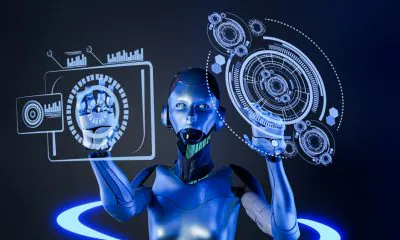Robotics
Engineers Create AI From Only a Sheet of Glass

A group of engineers and scientists at the University of Wisconsin-Madison have developed AI that is made from only a piece of glass with no sensors, circuits, or power sources. This is based on the same technology used for facial recognition in today’s smartphones, but it is much more simple. Professor of Electrical and Computer Engineering, Zongfu Yu, commented on the new research that has been published in Photonics Research.
“We’re using optics to condense the normal setup of cameras, sensors, and deep neural networks into a single piece of thin glass.”
As of now, AI uses a lot of computational resources and energy for things like facial recognition. With this new technology, the simple sheet of glass could possibly do the same thing but with absolutely no power source.
This exciting new AI is multiple pieces of glass that look like translucent squares. Within this glass are bubbles and other small impurities that are spread throughout certain locations. These work by bending light so that it can detect certain images. Instead of using codes, this glass is able to work with analog material only.
“We’re accustomed to digital computing, but this has broadened our view…The wave dynamics of light propagation provide a new way to perform analog artificial neural computing.” says Zongfu Yu.
Since this new type of AI glass does not rely on any type of power, circuits, or internet, it can last much longer. According to the engineers and scientists, there’s no reason to believe that one piece of glass couldn’t last for thousands of years.
According to Yu, “We could potentially use the glass as a biometric lock, tuned to recognize only one person’s face…Once built, it would last forever without needing power or internet, meaning it could keep something safe for you even after thousands of years.”
If implemented into something like a smartphone, this technology would drastically improve the battery life since the phone would no longer have to dedicate large amounts of energy to things like facial recognition. To top it all off, the piece of glass is an inexpensive creation.
The engineers and researchers at the University of Wisconsin-Madison figured out a way to take glass pieces and use them to identify written numbers. Light came from one of the written numbers and into the sheet of glass On the other side, there were nine spots that correspond to different digits. The light then focused on one of those as it moved through the glass. The engineers and scientists kept adjusting the location of the bubbles and impurities by small movements. After thousands of alterations, the glass was able to detect when a handwritten #3 was changed to a #8.
The engineers now want to push this further and try to get it to work with things like facial recognition. This technology could really change the way AI operates, and it could play a big role in the development of more complex systems in the future.
According to Ming Yuan, a Professor of Statistics at Columbia University who worked with the researchers, “The true power of this technology lies in its ability to handle much more complex classification tasks instantly without an energy consumption…These tasks are the key to create artificial intelligence; to teach driverless cars to recognize a traffic signal, to enable voice control in consumer devices, among numerous other examples.”
If this technology keeps getting developed further, it could really change the way some of our AI operates. The possibilities are endless when you have a simple sheet of glass that can perform the complex actions of something like facial recognition technology.














